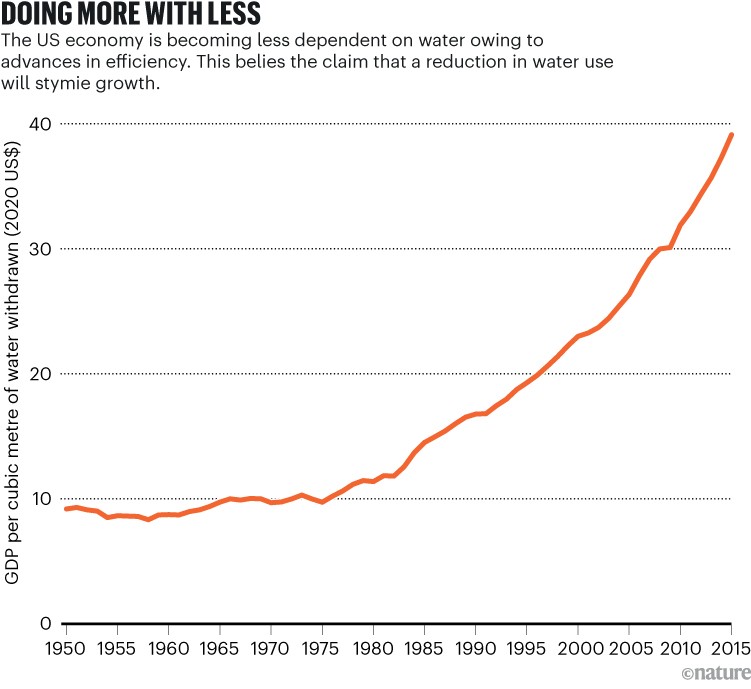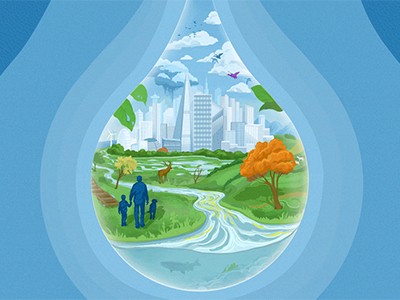Floods, droughts, pollution, water scarcity and conflict — humanity’s relationship with water is deteriorating, and it is threatening our health and well-being, as well as that of the environment that sustains us. The good news is that a transition from the water policies and technologies of past centuries to more effective and equitable ways of using and preserving this vital resource is not only possible, but under way. The challenge is to accelerate and broaden the transition.
Water policies have typically fostered a reliance on centralized, often massive infrastructure, such as big dams for flood and drought protection, and aqueducts and pipelines to move water long distances. Governments have also created narrow institutions focused on water, to the detriment of the interconnected issues of food security, climate, energy and ecosystem health. The key assumption of these ‘hard path’ strategies is that society must find more and more supply to meet what was assumed to be never-ending increases in demand.
That focus on supply has brought great benefits to many people, but it has also had unintended and increasingly negative consequences. Among these are the failure to provide safe water and sanitation to all; unsustainable overdraft of ground water to produce the food and fibre that the world’s 8 billion people need; inadequate regulation of water pollutants; massive ecological disruption of aquatic ecosystems; political and violent conflict over water resources; and now, accelerating climate disruption to water systems1.
A shift away from the supply-oriented hard path is possible — and necessary. Central to this change will be a transition to a focus on demand, efficiency and reuse, and on protecting and restoring ecosystems harmed by centuries of abuse. Society must move away from thinking about how to take more water from already over-tapped rivers, lakes and aquifers, and instead find ways to do the things we want with less water. These include, water technologies to transform industries and allow people to grow more food; appliances to reduce the amount of water used to flush toilets, and wash clothes and dishes; finding and plugging leaks in water-distribution systems and homes; and collecting, treating and reusing waste water.
Remarkably, and unbeknown to most people, the transition to a more efficient and sustainable future is already under way.
Singapore and Israel, two highly water-stressed regions, use much less water per person than do other high-income countries, and they recycle, treat and reuse more than 80% of their waste water2. New technologies, including precision irrigation, real-time soil-moisture monitoring and highly localized weather-forecasting models, allow farmers to boost yields and crop quality while cutting water use. Damaging, costly and dangerous dams are being removed, helping to restore rivers and fisheries.

Source: US Geological Survey
In the United States, total water use is decreasing even though the population and the economy are expanding. Water withdrawals are much less today than they were 50 years ago (see ‘A dip in use’) — evidence that an efficiency revolution is under way. And the United States is indeed doing more with less, because during this time, there has been a marked increase in the economic productivity of water use, measured as units of gross domestic product per unit of water used (see ‘Doing more with less’). Similar trends are evident in many other countries.

Source: US Geological Survey/US Department of Commerce.
Overcoming barriers
The challenge is how to accelerate this transition and overcome barriers to more sustainable and equitable water systems. One important obstacle is the lack of adequate financing and investment in expanding, upgrading and maintaining water systems. Others are institutional resistance in the form of weak or misdirected regulations, antiquated water-rights laws, and inadequate training of water managers with outdated ideas and tools. Another is blind adherence by authorities to old-fashioned ideas or simple ignorance about both the risks of the hard path and the potential of alternatives.
Funding for the modernization of water systems must be increased. In the United States, President Biden’s Infrastructure Investment and Jobs Act provides US$82.5 billion for water-related programmes, including removing toxic lead pipes and providing water services to long-neglected front-line communities. These communities include those dependent on unregulated rural water systems, farm-worker communities in California’s Central Valley, Indigenous populations and those in low-income urban centres with deteriorating infrastructure. That’s a good start. But more public- and private-investments are needed, especially to provide modern water and sanitation systems globally for those who still lack them, and to improve efficiency and reuse.
Regulations have been helpful in setting standards to cut waste and improve water quality, but further standards — and stronger enforcement — are needed to protect against new pollutants. Providing information on how to cut food waste on farms and in food processing, and how to shift diets to less water-intensive food choices can help producers and consumers to reduce their water footprints3. Corporations must expand water stewardship efforts in their operations and supply chains. Water institutions must be reformed and integrated with those that deal with energy and climate challenges. And we must return water to the environment to restore ecological systems that, in turn, protect human health and well-being.
In short, the status quo is not acceptable. Efforts must be made at all levels to accelerate the shift from simply supplying more water to meeting human and ecological water needs as carefully and efficiently as possible. No new technologies need to be invented for this to happen, and the economic costs of the transition are much less than the costs of failing to do so. Individuals, communities, corporations and governments all have a part to play. A sustainable water future is possible if we choose the right path.



 Water: a source of life and strife
Water: a source of life and strife
 Fresh water from thin air
Fresh water from thin air
 How to take ‘forever’ out of forever chemicals
How to take ‘forever’ out of forever chemicals
 The human factor in water disasters
The human factor in water disasters
 Sizing up hydrogen’s hydrological footprint
Sizing up hydrogen’s hydrological footprint
 Water and warfare: the battle to control a precious resource
Water and warfare: the battle to control a precious resource
 Webcast: How water researchers are rethinking the global flood crisis
Webcast: How water researchers are rethinking the global flood crisis





